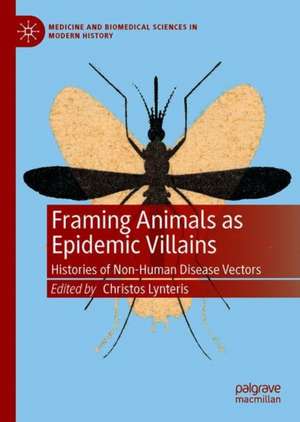Framing Animals as Epidemic Villains: Histories of Non-Human Disease Vectors: Medicine and Biomedical Sciences in Modern History
Editat de Christos Lynterisen Limba Engleză Hardback – 23 oct 2019
| Toate formatele și edițiile | Preț | Express |
|---|---|---|
| Paperback (1) | 778.01 lei 6-8 săpt. | |
| Springer International Publishing – 23 oct 2020 | 778.01 lei 6-8 săpt. | |
| Hardback (1) | 691.97 lei 3-5 săpt. | +24.95 lei 4-10 zile |
| Springer International Publishing – 23 oct 2019 | 691.97 lei 3-5 săpt. | +24.95 lei 4-10 zile |
Din seria Medicine and Biomedical Sciences in Modern History
-
 Preț: 454.16 lei
Preț: 454.16 lei -
 Preț: 282.19 lei
Preț: 282.19 lei - 20%
 Preț: 691.10 lei
Preț: 691.10 lei - 18%
 Preț: 781.77 lei
Preț: 781.77 lei - 15%
 Preț: 650.69 lei
Preț: 650.69 lei - 15%
 Preț: 584.26 lei
Preț: 584.26 lei - 15%
 Preț: 645.14 lei
Preț: 645.14 lei - 18%
 Preț: 727.80 lei
Preț: 727.80 lei -
 Preț: 167.93 lei
Preț: 167.93 lei - 18%
 Preț: 786.04 lei
Preț: 786.04 lei - 15%
 Preț: 650.37 lei
Preț: 650.37 lei -
 Preț: 231.67 lei
Preț: 231.67 lei - 15%
 Preț: 585.90 lei
Preț: 585.90 lei -
 Preț: 220.13 lei
Preț: 220.13 lei - 15%
 Preț: 585.40 lei
Preț: 585.40 lei - 18%
 Preț: 997.71 lei
Preț: 997.71 lei - 18%
 Preț: 785.11 lei
Preț: 785.11 lei - 18%
 Preț: 780.68 lei
Preț: 780.68 lei - 15%
 Preț: 643.00 lei
Preț: 643.00 lei - 18%
 Preț: 780.68 lei
Preț: 780.68 lei - 18%
 Preț: 900.94 lei
Preț: 900.94 lei - 18%
 Preț: 732.52 lei
Preț: 732.52 lei
Preț: 691.97 lei
Preț vechi: 864.97 lei
-20% Nou
Puncte Express: 1038
Preț estimativ în valută:
132.45€ • 143.92$ • 111.33£
132.45€ • 143.92$ • 111.33£
Carte disponibilă
Livrare economică 01-15 aprilie
Livrare express 15-21 martie pentru 34.94 lei
Preluare comenzi: 021 569.72.76
Specificații
ISBN-13: 9783030267940
ISBN-10: 3030267946
Pagini: 351
Ilustrații: XX, 247 p. 16 illus., 1 illus. in color.
Dimensiuni: 148 x 210 x 18 mm
Greutate: 0.59 kg
Ediția:1st ed. 2019
Editura: Springer International Publishing
Colecția Palgrave Macmillan
Seria Medicine and Biomedical Sciences in Modern History
Locul publicării:Cham, Switzerland
ISBN-10: 3030267946
Pagini: 351
Ilustrații: XX, 247 p. 16 illus., 1 illus. in color.
Dimensiuni: 148 x 210 x 18 mm
Greutate: 0.59 kg
Ediția:1st ed. 2019
Editura: Springer International Publishing
Colecția Palgrave Macmillan
Seria Medicine and Biomedical Sciences in Modern History
Locul publicării:Cham, Switzerland
Cuprins
Introduction: Infectious Animals and Epidemic Blame, Christos Lynteris.- Chapter 1. Vermin Landscapes: Suffolk, England, Shaped by Plague, Rat and Flea 1906-1920, Karen Sayer.- Chapter 2. Tarbagan’s Winter Lair: Framing Drivers of Plague Persistence in Inner Asia, Christos Lynteris.- Chapter 3. To Kill or not to Kill? Negotiating Life, Death, and One Health in the Context of Dog-Mediated Rabies Control in Colonial and Independent India, Deborah Nadal.- Chapter 4. Tiger Mosquitoes from Ross to Gates, Maurits Meerwijk.- Chapter 5. A Vector in The (Re)Making: A History of Aedes aegypti as Mosquitoes that Transmit Diseases in Brazil, Gabriel Lopes and Luísa Reis-Castro.- Chapter 6. Contesting the (Super)natural Origins of Ebola in Macenta, Guinea: Biomedical and Popular Approaches, Séverine Thys.- Chapter 7. Zika Outbreak in Brazil: In Times of Political and Scientific Uncertainties Mosquitoes Can be Stronger than a Country, Gustavo Corrêa Matta , Lenir Nascimento da Silva, ElaineTeixeira Rabello, and Carolina de Oliveira Nogueira.- 8 Postscript: Epidemic Villains and the Ecologies of Nuisance, Frédéric Keck.
Notă biografică
Christos Lynteris is Senior Lecturer in Social Anthropology at the University of St Andrews, UK. A medical anthropologist investigating epistemological, biopolitical, and visual aspects of infectious disease epidemics, he is the author of The Spirit of Selflessness in Maoist China (Palgrave Macmillan, 2012) Ethnographic Plague (Palgrave Macmillan, 2016), and co-author with Lukas Engelmann of Sulphuric Utopias: The History of Maritime Sanitation (forthcoming, 2020).
Textul de pe ultima copertă
This book takes a historical and anthropological approach to understanding how non-human hosts and vectors of diseases are understood, at a time when emerging infectious diseases are one of the central concerns of global health. The volume critically examines the ways in which animals have come to be framed as ‘epidemic villains’ since the turn of the nineteenth century. Providing epistemological and social histories of non-human epidemic blame, as well as ethnographic perspectives on its recent manifestations, the essays explore this cornerstone of modern epidemiology and public health alongside its continuing importance in today’s world. Covering diverse regions, the book argues that framing animals as spreaders and reservoirs of infectious diseases – from plague to rabies to Ebola – is an integral aspect not only to scientific breakthroughs but also to the ideological and biopolitical apparatus of modern medicine. As the first book to consider the impact of the image of non-human disease hosts and vectors on medicine and public health, it offers a major contribution to our understanding of human-animal interaction under the shadow of global epidemic threat.
Caracteristici
Explores historical perspectives on non-human hosts and vectors of disease, exploring how the framing of animals as ‘epidemic villains’ has shaped medicine and public health Chapters cover a range of human-animal interactions across a number of regions and diseases Shows how our understanding of animals as carriers and causes of disease result from entangled ethical, aesthetic, epistemological and political ideas
